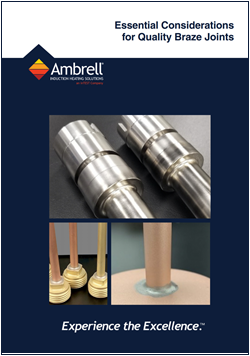Curing Material on an Aluminum Mandrel
Objective Heat a customer supplied aluminum cylinder to 80-120°C for a material curing application. More application notes
Processes
Processes: More
Processes: More

Industries:
Industries: More
Industries: More
Industries: More

Products:
Products: More
Services:
Services: More

Learn:
Learn: More
About:


We're pleased to announce that a new brazing white paper is now available. It is titled "Essential Considerations for Quality Braze Joints" and it is authored by Dr. Girish Dahake from THE LAB at Ambrell. This technical 12-page paper will help you decide whether brazing is the right solution for your application and then take you through all of the steps to braze successfully.
Our new brazing guide covers the following topics:
Here's an except from the introduction:
Metal joining with brazing is a commonly used technique in the manufacturing industry. Not only does this process produce parts that are stronger than the parent material, it also simplifies the manufacturing process. A number of complex parts can be made easily and repeatedly by combining more simply designed parts. Brazing can be used to join similar metals as well as dissimilar metals. Brazing is used in a plethora of industries including medical, aerospace, automotive and food.
The process of brazing involves the joining of two or more metal parts by heating them and using a third metal (braze alloy) which melts between them. It is important to have both parts reach the required brazing temperature at the same time. In lieu of this, the braze alloy tends to melt and stick to the part that is hotter and does not adhere well to the colder part. This produces what is commonly known as a ‘cold joint.’
Induction heating is a popular method for heating metal parts for brazing. A typical induction heating system is made up of an induction heating power supply, matching circuit and an induction heating coil. The induction heating coil is made of a water-cooled copper tube that has a high frequency alternating current flowing through it. This alternating current in the induction coil creates an intense magnetic field near the copper. The magnetic field produces an alternating current (eddy current) in the metal part placed in its vicinity. The eddy currents flow against the resistivity of the metal and produce heat. Induction heating is commonly used because of its speed, accuracy, repeatability and efficiency.
Register now to read the full white paper on "Essential Considerations for Quality Braze Joints."

Objective Heat a customer supplied aluminum cylinder to 80-120°C for a material curing application. More application notes

In today’s manufacturing landscape, efficiency, precision, and sustainability are critical. Induction heating—a process that uses electromagnetic...

When it comes to many manufacturing processes, including this forging application, precision and efficiency are critical. Traditional heating methods...